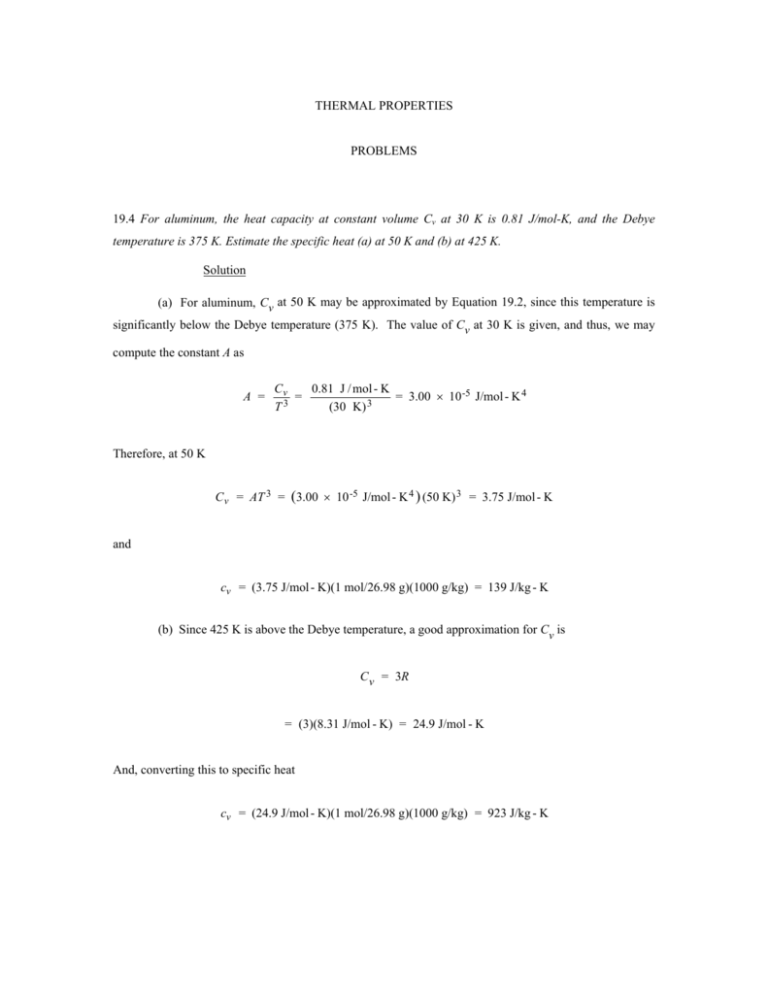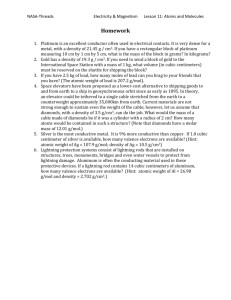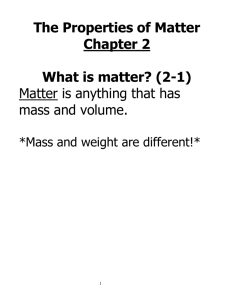THERMAL PROPERTIES PROBLEMS 19.4 For aluminum, the heat
advertisement

THERMAL PROPERTIES PROBLEMS 19.4 For aluminum, the heat capacity at constant volume Cv at 30 K is 0.81 J/mol-K, and the Debye temperature is 375 K. Estimate the specific heat (a) at 50 K and (b) at 425 K. Solution (a) For aluminum, Cv at 50 K may be approximated by Equation 19.2, since this temperature is significantly below the Debye temperature (375 K). The value of Cv at 30 K is given, and thus, we may compute the constant A as A = Cv 0.81 J / mol - K = = 3.00 10 -5 J/mol - K 4 (30 K) 3 T3 Therefore, at 50 K C v = AT 3 = (3.00 10 -5 J/mol - K 4 ) (50 K) 3 = 3.75 J/mol - K and cv = (3.75 J/mol - K)(1 mol/26.98 g)(1000 g/kg) = 139 J/kg - K (b) Since 425 K is above the Debye temperature, a good approximation for Cv is C v = 3R = (3)(8.31 J/mol - K) = 24.9 J/mol - K And, converting this to specific heat cv = (24.9 J/mol - K)(1 mol/26.98 g)(1000 g/kg) = 923 J/kg - K 19.12 When a metal is heated its density decreases. There are two sources that give rise to this diminishment of ρ: (1) the thermal expansion of the solid, and (2) the formation of vacancies (Section 4.2). Consider a specimen of copper at room temperature (20°C) that has a density of 8.940 g/cm3. (a) Determine its density upon heating to 1000°C when only thermal expansion is considered. (b) Repeat the calculation when the introduction of vacancies is taken into account. Assume that the energy of vacancy formation is 0.90 eV/atom, and that the volume coefficient of thermal expansion, αv is equal to 3αl. Solution (a) In this portion of the problem we are asked to determine the density of copper at 1000C on the basis of thermal expansion considerations. The basis for this determination will be 1 cm3 of material at 20C; this volume of copper has a mass of 8.940 g, which mass is assumed to remain constant upon heating to the 1000C. Let us first compute the volume expansion of this cubic centimeter of copper as it is heated to 1000C. According to Equation 19.4 volume expansion is equal to V = v T V0 where v, the volume coefficient of thermal expansion, as stipulated in the problem statement, is equal to 3l. The value of l given in Table 19.1 for copper is 17.0 10-6 (C)-1. Therefore, the volume of this specimen of Cu at 1000C (V) is equal to V = V0 + V = V0 + V0 v T V0 (1 v T ) V0 (1 3 l T ) V0 1 3 l (T f T0 ) = (1 cm3) 1 (3) 17.0 106 (C)1 (1000C 20C) = 1.04998 cm3 Thus, the density is just the 8.940 g divided by this new volume—i.e., = 8.940 g = 8.514 g/cm3 1.04998 cm3 (b) Now we are asked to compute the density at 1000C taking into consideration the creation of vacancies which will further lower the density. To begin, this determination requires that we calculate the number of vacancies using Equation 4.1. But it first becomes necessary to compute the number of Cu atoms per cubic centimeter (NCu) at 1000C using Equation 4.2. Thus, N A Cu ACu N Cu = = (6.022 10 23 atoms / mol)(8.514 g/cm3) 63.55 g/mol = 8.07 10 22 atoms/cm3 Now, from Equation 4.1, the total number of vacancies, Nv, is computed as Q N v = N Cu exp v kT 0.90 eV / atom = (8.07 10 22 atoms/cm3 ) exp (8.62 105 eV / K) (1000 273 K) = 2.212 1019 vacancies/cm3 We now want to determine the number of vacancies per unit cell, which is possible if the unit cell volume is multiplied by Nv. The unit cell volume (VC) may be calculated using Equation 3.5 taking n = 4 inasmuch as Cu has the FCC crystal structure. Thus, from a rearranged form of Equation 3.5 VC = = nACu Cu N A (4 atoms/unit cell)(63.55 g/mol) (8.514 g/cm3)(6.022 10 23 atoms / mol) = 4.958 10 -23 cm3/unit cell Now, the number of vacancies per unit cell, nv, is just nv = N vVC = (2.212 1019 vacancies/cm3 )(4.958 10 -23 cm3/unit cell) = 0.001097 vacancies/unit cell What this means is that instead of there being 4.0000 atoms per unit cell, there are only 4.0000 – 0.001097 = 3.998903 atoms per unit cell. And, finally, the density may be computed using Equation 3.5 taking n = 3.998903; thus Cu = nACu VC N A (3.998903 atoms/unit cell)(63.55 g/mol) (4.958 1023 cm3/unit cell)(6.022 10 23 atoms / mol) = = 8.512 g/cm3 Thus, the influence of the vacancies is almost insignificant--their presence reduces the density by only 0.002 g/cm3 (from 8.514 g/cm3 to 8.512 g/cm3). 19.26 (a) If a rod of 1025 steel 0.5 m (19.7 in.) long is heated from 20 to 80°C (68 to 176°F) while its ends are maintained rigid, determine the type and magnitude of stress that develops. Assume that at 20°C the rod is stress free. (b) What will be the stress magnitude if a rod 1 m (39.4 in.) long is used? (c) If the rod in part (a) is cooled from 20 to -10°C (68 to 14°F), what type and magnitude of stress will result? Solution (a) We are asked to compute the magnitude of the stress within a 1025 steel rod that is heated while its ends are maintained rigid. To do this we employ Equation 19.8, using a value of 207 GPa for the modulus of elasticity of steel (Table 6.1), and a value of 12.0 10-6 (C)-1 for l (Table 19.1). Therefore = E l (T0 T f ) = (207 10 3 MPa) 12.0 106 (C)1 (20C 80C) = –150 MPa (–21,800 psi) The stress will be compressive since its sign is negative. (b) The stress will be the same [–150 MPa (–21,800 psi )], since stress is independent of bar length. (c) Upon cooling the indicated amount, the stress becomes = E l (T0 T f ) = (207 10 3 MPa) 12.0 106 (C)1 (20C (10C) = +74.5 MPa (+10,900 psi) This stress will be tensile since its sign is positive.





